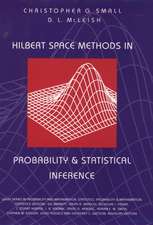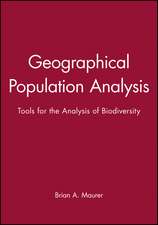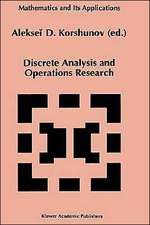Infinite-dimensional Lie algebras
Autor R.K. Amayo, Ian Stewarten Limba Engleză Paperback – 9 dec 2011
Preț: 399.88 lei
Nou
Puncte Express: 600
Preț estimativ în valută:
76.51€ • 80.10$ • 63.31£
76.51€ • 80.10$ • 63.31£
Carte tipărită la comandă
Livrare economică 07-21 aprilie
Preluare comenzi: 021 569.72.76
Specificații
ISBN-13: 9789401023078
ISBN-10: 9401023077
Pagini: 440
Ilustrații: 436 p.
Dimensiuni: 170 x 244 x 23 mm
Greutate: 0.69 kg
Ediția:Softcover reprint of the original 1st ed. 1974
Editura: SPRINGER NETHERLANDS
Colecția Springer
Locul publicării:Dordrecht, Netherlands
ISBN-10: 9401023077
Pagini: 440
Ilustrații: 436 p.
Dimensiuni: 170 x 244 x 23 mm
Greutate: 0.69 kg
Ediția:Softcover reprint of the original 1st ed. 1974
Editura: SPRINGER NETHERLANDS
Colecția Springer
Locul publicării:Dordrecht, Netherlands
Public țintă
ResearchCuprins
1. Basic concepts.- 1. Preliminaries.- 2. Nilpotency and solubility.- 3. Subideals.- 4. Derivations.- 5. Classes and closure operations.- 6. Representations and modules.- 7. Chain conditions.- 8. Series.- 2. Soluble subideals.- 1. The circle product.- 2. The Derived Join Theorems.- 3. Coalescent classes of Lie algebras.- 1. An example.- 2. Coalescence of classes with minimal conditions.- 3. Coalescence of classes with maximal conditions.- 4. The local coalescence of D.- 5. A counterexample.- 4. Locally coalescent classes of Lie algebras.- 1. The algebra of formal power series.- 2. Complete and locally coalescent classes.- 3. Acceptable subalgebras.- 5. The Mal’cev correspondence.- 1. The Campbell-Hausdorff formula.- 2. Complete groups.- 3. The matrix version.- 4. Inversion of the Campbell-Hausdorff formula.- 5. The general version.- 6. Explicit descriptions.- 6. Locally nilpotent radicals.- 1. The Hirsch-Plotkin radical.- 2. Baer, Fitting, and Gruenberg radicals.- 3. Behaviour under derivations.- 4. Baer and Fitting algebras.- 5. The Levi?-Tokarenko theorem.- 7. Lie algebras in which every subalgebra is a subideal.- 1. Nilpotent subideals.- 2. The key lemma and some applications.- 3. Engel conditions.- 4. A counterexample.- 5. Unsin’s algebras.- 8. Chain conditions for subideals.- 1. Classes related to Min-si.- 2. The structure of algebras in Min-si.- 3. The case of prime characteristic.- 4. Examples of algebras with Min-si.- 5. Min-si in special classes of algebras.- 6. Max-si in special classes of algebras.- 7. Examples of algebras satisfying Max-si.- 9. Chain conditions on ascendant abelian subalgebras.- 1. Maximal conditions.- 2. Minimal conditions.- 3. Applications.- 10. Existence theorems for abelian subalgebras.- 1. Generalised soluble classes.- 2. Locallyfinite algebras.- 3. Generalisations of Witt algebras.- 11. Finiteness conditions for soluble Lie algebras.- 1. The maximal condition for ideals.- 2. The double chain condition.- 3. Residual finiteness.- 4. Stuntedness.- 12. Frattini theory.- 1. The Frattini subalgebra.- 2. Soluble algebras: preliminary reductions.- 3. Proof of the main theorem.- 4. Nilpotency criteria.- 5. A splitting theorem.- 13. Neoclassical structure theory.- 1. Classical structure theory.- 2. Local subideals.- 3. Radicals in locally finite algebras.- 4. Semisimplicity.- 5. Levi factors.- 14. Varieties.- 1. Verbal properties.- 2. Invariance properties of verbal ideals.- 3. Ellipticity.- 4. Marginal properties.- 5. Hall varieties.- 15. The finite basis problem.- 1. Nilpotent varieties.- 2. Partially well ordered sets.- 3. Metabelian varieties.- 4. Non-finitely based varieties.- 5. Class 2-by-abelian varieties.- 16. Engel conditions.- 1. The second and third Engel conditions.- 2. A non-locally nilpotent Engel algebra.- 3. Finiteness conditions on Engel algebras.- 4. Left and right Engel elements.- 17. Kostrikin’s theorem.- 1. The Burnside problem.- 2. Basic computational results.- 3. The existence of an element of order 2.- 4. Elements which generate abelian ideals.- 5. Algebras generated by elements of order 2.- 6. A weakened form of Kostrikin’s theorem.- 7. Sketch proof of Kostrikin’s theorem.- 18. Razmyslov’s theorem.- 1. The construction.- 2. Proof of non-nilpotence.- Some open questions.- References.- Notation index.
























